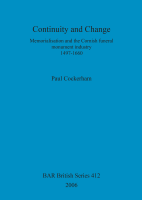Description
BOOK DESCRIPTION'Memorialisation and the Cornish Funeral Monument Industry 1497-1660' presents an extensive appraisal of several cohesive style groups of monuments, being the products of specific monument workshops in Cornwall, SW England, from the end of the fifteenth century to the Commonwealth. People used memorials to make statements. By examining every Cornish monument from 1497 to 1660the good, the unprepossessing, and the downright badit is only then, with this mass of information, that one can truly contextualise motivations across the social spectrum and comprehend the contemporary meaning of the monuments to the county's inhabitants. These statements provide direct contemporary evidence as regards the identity of the commemoratedespecially their Cornishnessand crucially how they sensed their identity then, rather than how we judge it now. In this work the tombs themselves are described, their iconography, design sources and sculptural perspectives are explored, and the motives of the patrons are deduced. The author goes on to discuss the methods and motives of Cornish memorialisation, identifying an unusual if not uniquesustained surge in monument commissions from Cornish workshops towards the end of the sixteenth century, using slate. The overall context of individual commemoration in Cornwall is analysed using wills and probate accounts as a guide to other means of remembrance, both pre- and post-Reformation, building on the motivations for tomb erection. This paradigm of Cornish memorialisation is compared with trends in Kilkenny, Ireland, and Finistère, France, to open up a matrix of memorialisation in the Celtic / Atlantic periphery. One of the discourses of a tomb which is frequently overlooked is its location in the church itself, therefore the author analyses monument positions to reveal how factors such as lineage status, and monumental continuity, affected the positioning of tombs. In the Appendices, the database of Cornish monuments acts as a reference tool to the arguments in the text of thisbook. The monuments of Kilkenny and Finistère are similarly itemised, together with analyses of masons' and helliers' probate documents, wider sets of Cornish wills, and lists of individually priced burial locations in St Neot and Liskeard. Numerous illustrations of the monuments themselves are also presented, most of which have never been pictured before.











